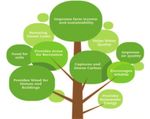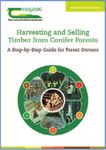FORESTRY The benefits of trees
←
→
Page content transcription
If your browser does not render page correctly, please read the page content below
Teagasc
Advisory
Newsletter
FORESTRY February 2022
The benefits of trees Edited by
Frances McHugh,
Forestry Development
Officer
A question for every landowner: how can
you plan for some level of tree planting to
maximise the potential benefits?
With a new Common Agricultural Policy
(CAP) around the corner, along with a new
Forestry Programme, now is a great time to
reflect on land use and plan towards how we
can shape farms and the broader rural
landscape to maximise environmental
benefits, while optimising food and timber
production (Figure 1).
While policymakers endeavour to create
supports to facilitate this optimum land use,
FIGURE 1: A range of benefits from trees.
landowners can also look around to see at
farm level where trees might be planted. planting a new woodland on a larger scale,
While tree planting is generously supported this decision must be made with a view to
through grants and premium payments, trees being there for generations to come.
landowners have to take on the reality that This continuity of tree cover aims to future-
planting trees is a long-term decision. proof the benefits from trees, such as carbon
Whether planting trees in a field corner, or capture, soil stability, and water protection.FORESTRY
February 2022
Harvesting and selling timber from
conifer forests
A step-by-step guide called along with required
‘Harvesting and Selling preparation in the forest, all
Timber from Conifer Forests’, need a significant lead-in
is now available. This time.
publication is very timely, as The key messages for owners
the forecasted increase in considering forest
timber supply to the Irish management and timber
market in future years will sales as set out in this booklet
come almost exclusively from are: start the process in good
privately-owned forests. time; access good advice;
The mobilisation of this engage people who will work
important supply is with you for the benefit of
dependent on timely and your forest; and, have a good
active management of what is contract in place to ensure a
traditionally referred to as the successful outcome. This
“farm forest”. Active management approach will greatly help in optimising your
commences with individual forest owners valuable forest resource. This booklet is
developing an awareness and understanding available from Teagasc at:
of their own forests. This allows for timely www.teagasc.ie/media/website/crops/forestry/
planning of activities, such as providing advice/Harvesting-and-Selling-Timber-from-
suitable access to forests. Conifer-Forests.pdf, or a hard copy is available
Forest management is a relatively new by phoning 091-845 200.
venture for many forest owners. The steps
involved in organising forest harvests and
timber sales, including knowing where to
start and who to approach, can be
challenging, particularly if putting the initial
‘toe in the water’.
This booklet offers a step-by-step guide to
forest owners in getting timber from their
conifer forests to the marketplace. Teagasc
recommends that planning for this process
begins in good time, i.e., a few years out
from the actual harvest. Gaining knowledge
of timber assortments and products, the
The booklet offers a step-by-step guide to selling timber
paperwork involved, the potential buyers, from conifer forests.FORESTRY
February 2022
RESEARCH UPDATE
Genetic diversity
DHEERAJ SINGH RATHORE reports on BroadGen, a study of the genetic diversity and
resilience of commercially important broadleaved tree species in Ireland.
Genetic diversity of tree species through tree diversify the population by adding genetically
breeding and improvement programmes will diverse genotypes to the seed orchards that are
enable new and existing forests to contribute suitable to Irish climatic conditions, as well as
positively to productivity and increase forest embrace their quality and productivity.
resilience to changing climate and potential In addition, verifying the disease tolerance of ash
biotic threats. and alder genotypes in the gene banks to their
In Ireland, we have conservation gene banks and major pathogens will improve the perception of
seed orchards of commercially important stakeholders towards these two species by
broadleaved tree species such as alder, ash, birch reducing concerns of their use in forestry.
(silver and downy), and sycamore. However, the Overall, findings from the BroadGen project will
genetic diversity of these tree species in the Irish deliver greater understanding of the extent and
gene banks and seed orchards remains nature of genetic diversity and resilience in gene
understudied. bank collections, thereby enhancing the role of
Therefore, the BroadGen project is focused on: these resources in improvement programmes of
(1) evaluating the genetic diversity of the alder, these broadleaved tree species in Ireland.
birch, and sycamore tree species in Irish gene
banks; and, (2) assessing the susceptibility of ash Funding: The BroadGen project is funded by
and alder gene banks to ash dieback and Teagasc under the Walsh Scholarship
Phytophthora, respectively. Programme for four years.
The research will characterise genetic
relationships within and among the tree For further information on Teagasc research,
populations of each tree species. The project will see: www.teagasc.ie/forestry.
utilise the techniques of molecular biology, DNA
fingerprinting, bioinformatics, and plant
pathology to understand the genetic relationship
among the individual trees, as well their
resilience to existing diseases for ash and alder in
Ireland.
Also, the genetic profiling of the seed orchards
Design by Think Media.
for broadleaved species will maximise their
utilisation and complement the previous work
and time invested in the establishment of these
seed orchards. The results will indicate whether
the existing seed orchards of these broadleaved
tree species are diverse enough to continue our
reliance on them, or whether we need to BroadGen will assess the genetic diversity of tree species in
Irish gene banks.
For further information on any issues raised in this newsletter, or to access other
enterprise newsletters, please contact your local Teagasc adviser or see www.teagasc.ie.You can also read























































